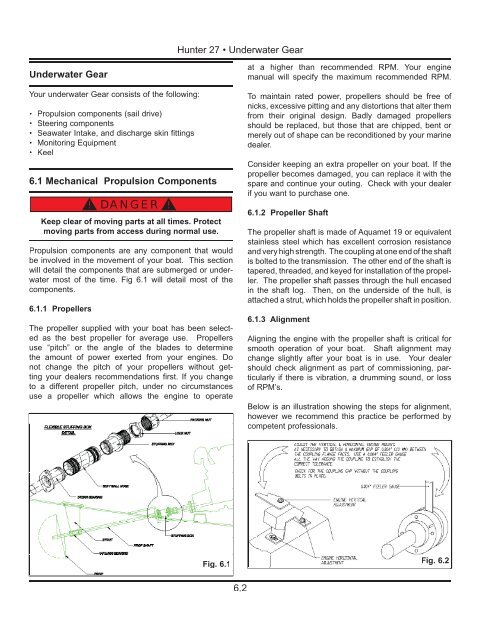27 Operator's Manual.. - Marlow-Hunter, LLC
27 Operator's Manual.. - Marlow-Hunter, LLC
27 Operator's Manual.. - Marlow-Hunter, LLC
You also want an ePaper? Increase the reach of your titles
YUMPU automatically turns print PDFs into web optimized ePapers that Google loves.
<strong>Hunter</strong> <strong>27</strong> • Underwater Gear<br />
Underwater Gear<br />
Your underwater Gear consists of the following:<br />
•<br />
•<br />
•<br />
•<br />
•<br />
Propulsion components (sail drive)<br />
Steering components<br />
Seawater Intake, and discharge skin fittings<br />
Monitoring Equipment<br />
Keel<br />
6.1 Mechanical Propulsion Components<br />
! DANGER !<br />
Keep clear of moving parts at all times. Protect<br />
moving parts from access during normal use.<br />
Propulsion components are any component that would<br />
be involved in the movement of your boat. This section<br />
will detail the components that are submerged or underwater<br />
most of the time. Fig 6.1 will detail most of the<br />
components.<br />
6.1.1 Propellers<br />
The propeller supplied with your boat has been selected<br />
as the best propeller for average use. Propellers<br />
use “pitch” or the angle of the blades to determine<br />
the amount of power exerted from your engines. Do<br />
not change the pitch of your propellers without getting<br />
your dealers recommendations first. If you change<br />
to a different propeller pitch, under no circumstances<br />
use a propeller which allows the engine to operate<br />
at a higher than recommended RPM. Your engine<br />
manual will specify the maximum recommended RPM.<br />
To maintain rated power, propellers should be free of<br />
nicks, excessive pitting and any distortions that alter them<br />
from their original design. Badly damaged propellers<br />
should be replaced, but those that are chipped, bent or<br />
merely out of shape can be reconditioned by your marine<br />
dealer.<br />
Consider keeping an extra propeller on your boat. If the<br />
propeller becomes damaged, you can replace it with the<br />
spare and continue your outing. Check with your dealer<br />
if you want to purchase one.<br />
6.1.2 Propeller Shaft<br />
The propeller shaft is made of Aquamet 19 or equivalent<br />
stainless steel which has excellent corrosion resistance<br />
and very high strength. The coupling at one end of the shaft<br />
is bolted to the transmission. The other end of the shaft is<br />
tapered, threaded, and keyed for installation of the propeller.<br />
The propeller shaft passes through the hull encased<br />
in the shaft log. Then, on the underside of the hull, is<br />
attached a strut, which holds the propeller shaft in position.<br />
6.1.3 Alignment<br />
Aligning the engine with the propeller shaft is critical for<br />
smooth operation of your boat. Shaft alignment may<br />
change slightly after your boat is in use. Your dealer<br />
should check alignment as part of commissioning, particularly<br />
if there is vibration, a drumming sound, or loss<br />
of RPM’s.<br />
Below is an illustration showing the steps for alignment,<br />
however we recommend this practice be performed by<br />
competent professionals.<br />
6.2

















